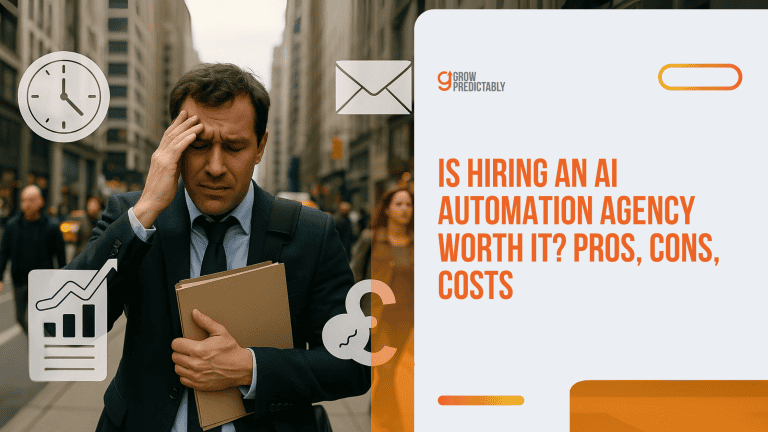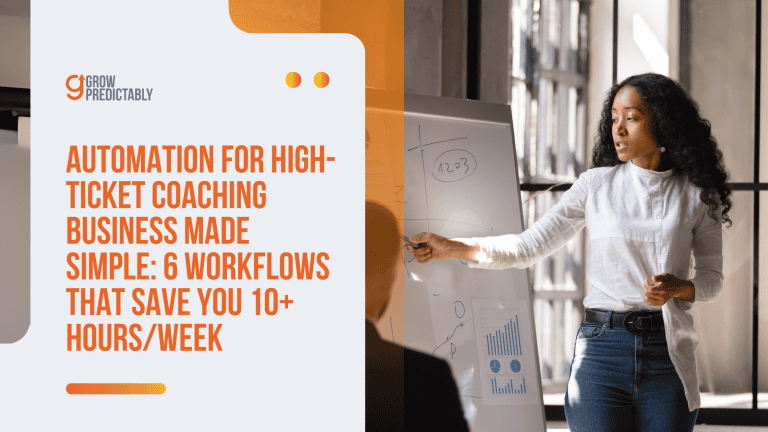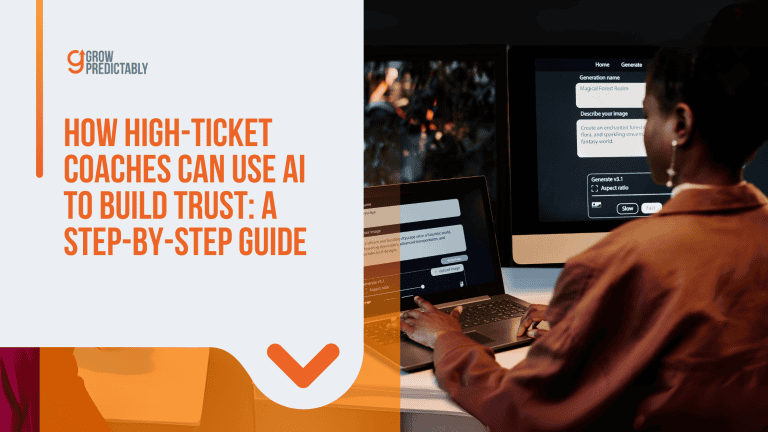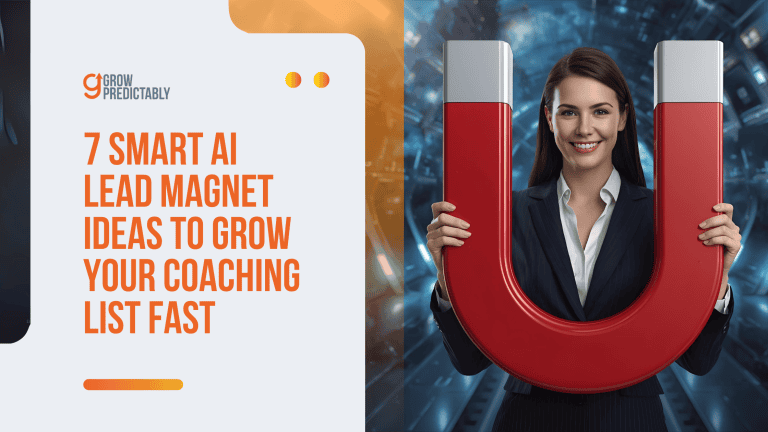How Can AI Help My High-Ticket Coaching Business? The Complete Implementation Guide
Here’s the benefit: AI can transform your high-ticket coaching business by making it feel both “large and personal,” helping you save real hours while boosting results across the board.
You’ll experience fewer admin headaches, better focus on the right leads, and meaningful touchpoints with your clients.
But here’s the catch: many coaches get stuck in the overwhelm, leading to stalled customer journeys and climbing churn rates.
Master this, and you’ll have clients who feel more connected, all while you manage to work less.
Curious about which steps and tools will answer your question, “How can AI help my high-ticket coaching business?” without causing burnout or losing your personal touch?
TL;DR
To effectively implement AI in your high-ticket coaching business, focus on building a detailed client profile using the Customer Avatar Canvas. Start by addressing one pain point at a time, and integrate AI tools to automate repetitive tasks. Continuously monitor and optimize these systems to ensure ongoing efficiency and improvement.
KEY TAKEAWAYS
- Begin by developing a comprehensive client profile including demographics, pain points, and goals to accurately guide AI tool selection.
- Choose initial AI tools that address your biggest time drains, such as scheduling automation or email management, and integrate them into your current systems.
- Regularly review and refine your AI processes, focusing on seamless tool integration and adapting to improve client experience and business outcomes.
Where Does a Successful Coaching Business Start?
Most coaches fail because they try to help everyone and end up helping no one.
You can’t build a million-dollar coaching business by casting the widest net possible.
Success comes from getting laser-focused on one specific type of person who desperately needs what you offer.
Building a strong client base is essential for sustainable growth and long-term success.
When you know exactly who you’re serving, everything becomes easier.
Your marketing messages hit harder.
Your content attracts the right people.
Your sales conversations convert clients at higher rates.
According to a 2024 Forrester Research, businesses that use buyer personas see a 73% higher conversion rate compared to those that don’t. (Source)
If you try to speak to everyone, you’ll end up speaking to no one.”
Seth Godin
How to Break Down Your Clients for Better Alignment
To truly understand your clients and attract high-ticket coaching clients, you need to go beyond basic demographics like age and income.
This surface-level information won’t make a significant impact.
Instead, focus on what makes your ideal client tick both psychologically and emotionally using a Customer Avatar Canvas.
Here’s how to effectively break down your client avatar into critical components:
- Demographics and Firmographics: Use basic details—age, income, job title, company size, industry, and location—to establish the initial framework.
- Pain Points and Frustrations: Identify the specific problems keeping them up at night, along with daily challenges they’re facing and what solutions they’ve already attempted that didn’t work.
- Goals and Aspirations: Determine where they aim to be in 6-12 months, what success means to them, and the deeper motivations driving their decisions.
- The Transformation Journey: Map out their current state versus their desired future state, and consider the emotional journey they’ll experience while working with you.
By mastering this level of clarity about your clients, your marketing messages will resonate more effectively and practically write themselves.
Understanding your clients deeply not only helps tailor your services but also differentiates you from amateurs, making you a professional who truly comprehends client needs.
Can AI Help You Understand Your Ideal Clients?
Yes, AI can significantly enhance your understanding of your ideal clients by shifting from guesswork to data-driven insights.
With AI’s prowess in pattern recognition across vast datasets, you can uncover hidden client insights that manual analysis might miss.
This enables the refinement of customer avatars using validated data rather than assumptions.
Here’s how you can leverage AI to develop more precise customer avatars:
- Survey Analysis: Tools like MonkeyLearn and Lexalytics excel at analyzing open-ended survey responses, identifying common themes, emotional triggers, and the language patterns your audience uses.
- Social Media Listening: Platforms such as Brandwatch and Sprout Social harness AI to monitor industry conversations, revealing pain points and desires that your potential clients express naturally.
- Website Behavior Tracking: AI-powered analytics tools like Hotjar and FullStory help you understand exactly how different visitor segments interact with your content, uncovering preferences and friction points.
- Email Engagement Analysis: Tools like Seventh Sense and Send Time Optimization allow you to explore when and how your audience engages with your emails, giving insights into their communication preferences.
Combining multiple data sources is key to building a comprehensive client picture.
A single data point might be misleading, but identifying patterns across multiple touchpoints with AI provides reliable insights that drive results.
Remember, your customer avatar will evolve as your business grows, and AI ensures this refinement process is continuous, keeping your marketing relevant and your offers converting effectively.
How to Enhance Your Client’s Experience at Every Step?
A systematic process is crucial to transforming strangers into paying clients and eventually loyal advocates who continually refer others to your coaching business.
Without a structured approach, many coaches find themselves relying on luck rather than strategy, contributing to a high failure rate.
Implementing the Customer Value Journey is essential for creating remarkable client experiences at each stage.
This framework ensures that every interaction—from the first website visit to ongoing client advocacy—contributes to sustainable business growth.
Effective management of this journey is vital, especially since acquiring a new client costs 5–25 times more than retaining an existing one, according to Bain & Company research.
The growing demand for high-quality coaching experiences makes it imperative to develop a clear, proven process.
This methodology isn’t theoretical; it’s the same approach adopted by successful coaching businesses. Understanding your market and its dynamics is critical to ensuring long-term success.
By adopting this framework, you’ll stand out among competitors and attract high-ticket clients, cultivating a thriving coaching practice.
Customer experience is the next competitive battleground.”
Jerry Gregoire, former CIO, Dell
What Are The 8 Stages of The Customer Journey?
Every potential client moves through eight distinct stages, and your job is to optimize each transition.
Miss one stage, and you’re leaving money on the table.
Nail all eight, and you’ve built a predictable revenue machine that scales without you.
The journey starts with complete strangers who don’t know you exist and ends with promoters who actively sell for you:
- Awareness – Getting your ideal prospects to notice you exist and recognize you as someone who can solve their problems
- Engagement – Capturing their attention long enough to demonstrate your expertise and build initial trust
- Subscribe – Converting anonymous visitors into known leads by exchanging value for their contact information
- Convert – Turning subscribers into paying customers through strategic offers and sales processes, where a successful sale is the natural result of genuine engagement and relationship-building, not just automation
- Excite – Delivering an amazing first experience that confirms they made the right decision choosing you
- Ascend – Moving satisfied clients to higher-value services and longer-term engagements
- Advocate – Transforming happy clients into case studies and success stories that attract more ideal prospects
- Promote – Turning advocates into active referral sources who consistently send you qualified leads
Each stage requires different strategies, messaging, and tools. What works for awareness won’t work for conversion. What excites new clients won’t necessarily make them advocate for you.
Can AI Assist in Optimizing Customer Journeys?
Artificial intelligence transforms each stage from manual guesswork into automated precision by integrating AI into your existing workflows for maximum impact.
Instead of hoping prospects move forward, you can now predict, influence, and optimize their progression through data-driven insights and automated responses.
Awareness: Intelligent Prospect Attraction
AI-powered tools identify and target your exact ideal clients across multiple channels simultaneously. Traditional advertising wastes money showing your message to everyone.
Smart AI systems analyze behavioral patterns, interests, and demographics to find people who match your successful client profiles.
AI can also enhance lead generation by identifying and targeting the most promising prospects, ensuring your outreach is focused and effective.
Google’s AI advertising platform can predict which keywords and audiences will convert 40% better than manual targeting.
Facebook’s AI analyzes over 4,000 data points per user to show your ads only to people likely to become clients.
LinkedIn’s AI targets based on professional behavior patterns that indicate buying readiness.
Content creation AI like Jasper and Copy.ai can generate blog posts, social media content, and video scripts optimized for your specific audience’s language patterns and interests.
These tools analyze what content performs best in your niche and replicate those elements automatically.
Engagement: Personalized Connection at Scale
Once prospects know you exist, AI helps maintain their attention through personalized interactions that feel human but scale infinitely.
Chatbots powered by natural language processing can have real conversations with website visitors, answering questions and qualifying leads 24/7.
Email automation tools like ActiveCampaign and ConvertKit use AI to determine the best times to send messages, optimal subject lines, and content that resonates with each subscriber segment.
According to a Salesforce resource on email marketing, personalized email campaigns generate 6x more transactions than generic blasts. (Source)
AI analyzes engagement patterns to identify when prospects are most likely to take the next step.
It can trigger personalized follow-ups based on specific behaviors like visiting your pricing page, downloading multiple resources, or spending significant time on testimonial pages.
Subscribe and Convert: Intelligent Lead Management
AI transforms how you capture and convert leads by predicting which prospects are most likely to buy and when they’re ready to make a decision.
By integrating AI into your sales process, you can improve efficiency and personalization at every stage.
Lead scoring algorithms analyze dozens of behavioral signals to rank prospects by purchase probability.
Tools like HubSpot and Salesforce use predictive analytics to identify hot leads before they raise their hand.
The AI tracks website behavior, email engagement, social media interactions, and demographic data to create composite scores that tell you exactly who to contact first.
Dynamic content personalization shows different offers and messaging based on each visitor’s profile and behavior history.
Someone who downloaded your advanced strategy guide sees different calls-to-action than someone who just subscribed to your newsletter.
AI tools can also help optimize sales pages for higher conversion rates, ensuring your messaging and offers are tailored to each visitor for maximum impact.
Excite and Ascend: Automated Success Acceleration
The moment someone becomes a client, AI takes over their onboarding and success journey.
Automated sequences deliver the right resources at the right time, track progress, and identify opportunities for additional services.
AI-powered course platforms like Thinkific and Teachable can adapt content delivery based on learning pace and comprehension.
If someone struggles with module two, the system can automatically provide additional resources or trigger a check-in from your team.
Upsell and cross-sell recommendations become surgical rather than spray-and-pray.
AI analyzes client success patterns to identify the perfect moment to introduce higher-value services.
It knows that clients who complete certain milestones are 3x more likely to invest in additional coaching.
Advocate and Promote: Systematic Referral Generation
AI automates the process of turning satisfied clients into active promoters.
Sentiment analysis tools monitor client communications to identify the perfect moment to request testimonials or referrals when satisfaction peaks.
Review management platforms like Podium and BirdEye use AI to automatically request reviews from happy clients while preventing dissatisfied clients from posting negative feedback publicly.
The systems can detect emotional tone in communications and only trigger review requests when sentiment is positive.
Referral tracking AI identifies patterns in your best referral sources and creates lookalike profiles to find similar advocates.
It can even predict which current clients are most likely to refer others based on engagement patterns and success metrics.
How to Start Using AI in Your Coaching Business Today
To start using AI in your coaching business, focus on addressing one pain point at a time rather than trying to overhaul everything simultaneously.
Begin by identifying your biggest time drain and prove the concept with a straightforward AI solution.
You don’t need a computer science degree or a massive budget; plenty of tools are available to automate tasks efficiently within weeks.
Follow a logical sequence that builds momentum, ensuring steady progress rather than chaos.
Staying updated on the latest AI technologies will help you maximize your business potential and leverage the most effective solutions, gradually expanding your AI capabilities for sustained growth and efficiency.
Step 1: Build Your Detailed Client Profile
Your client avatar becomes the foundation for every AI system you implement.
Without this clarity, you’re optimizing for the wrong people and wasting money on tools that don’t deliver results.
Most coaches think they know their ideal client but can’t articulate specifics beyond basic demographics.
This surface-level understanding kills AI effectiveness because the technology needs precise parameters to work properly.
Create a comprehensive profile that includes:
- Demographics and psychographics: Age, income, job title, personality traits, values, and lifestyle preferences
- Pain points and frustrations: Specific problems keeping them awake at night, failed solutions they’ve tried, and emotional impact of their challenges
- Goals and aspirations: Concrete outcomes they want to achieve, timeline expectations, and deeper motivations driving their decisions
- Communication preferences: How they like to receive information, preferred meeting times, and response expectations
- Success indicators: What achievement looks like to them and how they measure progress
Interview your best clients to validate these assumptions.
Ask about their journey before finding you, what almost stopped them from hiring you, and what they value most about your service.
Record these conversations so AI tools can analyze the language patterns later.
Step 2: Map Your Client Journey
Every client follows a predictable path from stranger to advocate.
Understanding this journey lets you identify where AI can eliminate friction and accelerate progress.
Document each stage your clients experience:
- Discovery phase: How they first learn about you and what captures their attention
- Evaluation period: What questions they ask, objections they raise, and information they need to decide
- Onboarding experience: First impressions, initial deliverables, and early wins that build confidence
- Active coaching: Session frequency, homework assignments, progress milestones, and support needs
- Completion and transition: Program wrap-up, success celebration, and next steps or referrals
For each stage, identify the communications, resources, and touchpoints currently happening.
Note where clients get stuck, what questions repeat constantly, and which transitions feel clunky or time-consuming.
This mapping reveals automation opportunities you might miss otherwise.
Maybe prospects ask the same five questions before booking a call.
Perhaps clients need similar resources after each session type.
These patterns become your first AI implementation targets.
Step 3: Audit Your Time Drains
Track your activities for one week to identify where time disappears.
Most coaches are shocked by how much energy goes into tasks that don’t directly serve clients or grow the business.
Log these categories throughout your week:
- Administrative tasks: Scheduling, invoicing, file management, and compliance activities
- Communication management: Email responses, text messages, and routine follow-ups
- Content creation: Social media posts, client resources, and marketing materials
- Session preparation: Note reviews, exercise planning, and research activities
- Client tracking: Progress updates, goal monitoring, and outcome measurement
Be honest about time spent on each activity.
Include transition time between tasks and the mental energy required to context-switch.
Many coaches underestimate how much administrative work fragments their day.
The rest gets consumed by interruptions, administrative tasks, and inefficient processes.
Step 4: Choose Your First AI Tools
Start with one or two tools that address your biggest time drains.
Trying to implement everything simultaneously creates overwhelm and reduces the likelihood of success.
High-impact starting points based on common coaching pain points:
- Scheduling automation: Tools like Calendly AI or Acuity Scheduling eliminate booking back-and-forth and reduce no-shows through automated reminders
- Email automation: Platforms like ConvertKit or ActiveCampaign handle follow-up sequences, client communications, and lead nurturing
- Content generation: AI writers like Jasper or Copy.ai create social media posts, email newsletters, and client resources
- Note-taking assistance: Tools like Otter.ai or Notion AI transcribe sessions and organize client information automatically
Choose tools that integrate with your existing systems rather than requiring complete platform changes.
Look for solutions with free trials so you can test effectiveness before committing to paid plans.
Implementation priority framework:
- Highest time savings – Tackle the activity consuming the most hours weekly
- Lowest learning curve – Choose tools you can master quickly without extensive training
- Immediate client impact – Focus on improvements clients will notice and appreciate
- Scalability potential – Select solutions that grow with your business
Step 5: Monitor and Optimize Continuously
AI implementation isn’t a set-it-and-forget-it process.
The most successful coaches treat it as an ongoing optimization project that improves over time.
Track these metrics weekly:
- Time savings: Hours reclaimed from automated tasks
- Client satisfaction: Feedback scores and retention rates
- Revenue impact: Changes in conversion rates and average client value
- System reliability: Automation failures or client complaints
- Personal stress levels: Energy and focus improvements from reduced administrative load
Set monthly review sessions to analyze what’s working and what needs adjustment.
AI tools learn from your feedback, so regularly training them on your preferences improves performance over time.
Common optimization areas:
- Message personalization: Refine AI-generated content to match your voice and client needs
- Automation triggers: Adjust when and how systems respond to client behaviors
- Integration improvements: Connect tools more seamlessly to reduce manual work
- Expansion opportunities: Identify new processes ready for automation
The goal isn’t perfection from day one.
It’s steady improvement that compounds over months and years.
Small optimizations create dramatic long-term results when applied consistently.
Start with one tool this week.
Master it completely before adding another.
This disciplined approach prevents overwhelm and ensures each system actually improves your coaching practice rather than creating new problems to solve.
How Can Coaching with AI Give Back Your Time
Coaching with AI can reclaim your valuable time by automating the tedious tasks that often bog you down.
By automating repetitive administrative duties, AI frees you to focus on high-value activities and deepen client relationships.
Smart coaches embrace AI to scale their impact and income, automating everything that doesn’t need their unique expertise.
This swift transformation allows you to get better client service, regain control of your time, and grow your business without the usual growing pains that crush many coaching practices.
By implementing the right systems, tasks that once took days now run smoothly in the background, enhancing your overall efficiency.
The real power of AI is not in replacing humans, but in freeing them from repetitive tasks.”
Fei-Fei Li, Stanford Professor & AI Expert
1. Eliminating Manual Busywork
Administrative tasks kill coaching businesses slowly.
Every minute you spend on scheduling, sending reminders, or updating spreadsheets is a minute stolen from serving clients or growing your business.
The hidden cost of these activities is not just lost time, but also lost opportunities for business growth and client engagement.
AI eliminates this time drain completely.
Modern scheduling AI goes far beyond basic calendar booking.
These systems handle the complex coordination that would take human assistants hours to manage:
- Smart scheduling: Coordinates across multiple time zones, accounts for travel time, and automatically reschedules conflicts
- Automated reminders: Sends appointment confirmations, session reminders, and follow-up messages based on triggers you set once
- Communication sequences: Handles homework assignments, progress check-ins, and client updates without manual intervention
- Document management: Organizes client files, tracks progress notes, and maintains compliance records automatically
Tools like Calendly AI and Acuity Scheduling eliminate the back-and-forth emails that eat up your day.
Systems like Practice Better and SimplePractice use AI to categorize information, flag important updates, and ensure nothing falls through the cracks.
A consultant can leverage AI to eliminate manual busywork, reduce the cost of inefficiency, and focus on delivering higher-value, personalized services to clients.
2. Personalized Content at Scale
Creating tailored content for different client segments used to require a full marketing team.
AI now generates personalized emails, social media posts, and resources for each client type in minutes instead of hours.
Content generation AI analyzes your successful communications and replicates what works.
The personalization goes deeper than changing names and demographics:
- Segment-specific messaging: Someone struggling with confidence gets different content than someone focused on business strategy. AI-generated content speaks directly to each client’s unique needs, ensuring messaging is relevant and impactful.
- Journey-based content: AI adapts messaging based on where clients are in their transformation process
- Behavioral triggers: Dynamic content delivery based on engagement patterns and learning progress
- Communication preferences: Adjusts tone, frequency, and format based on how each client likes to receive information
Tools like Jasper and Copy.ai create email sequences, blog posts, and social media content that feels personally written for each client segment, providing valuable support to clients throughout their journey.
The AI tracks what resonates and continuously improves the messaging for better results.
3. Pattern Recognition and Insight Generation
Human coaches miss patterns that could transform their practice.
AI processes thousands of data points from client sessions, feedback forms, and progress tracking to reveal game-changing insights.
The power of AI-driven data analysis can transform coaching outcomes by uncovering patterns and opportunities that would otherwise go unnoticed.
According to studies, companies using predictive analytics can help increase revenue by up to 15% through more effective sales and marketing strategies. (Source)
Coaching businesses experience similar improvements when AI identifies these critical patterns:
- Success indicators: Which client behaviors predict the best outcomes and fastest progress
- Risk factors: Early warning signs that someone might struggle or drop out before they verbalize concerns
- Intervention timing: The optimal moments to provide additional support or challenge clients to level up
- Methodology refinement: Which coaching techniques work best for different personality types and challenges
Session analysis AI transcribes and analyzes coaching calls to identify recurring themes and successful approaches.
Sentiment analysis reveals emotional patterns in client communications that might not be obvious in direct conversation.
4. Round-the-Clock Client Support
Your clients need support outside of scheduled sessions, but you can’t be available 24/7 without burning out.
Round-the-clock support is especially important for high ticket clients, who expect immediate and personalized assistance as part of their premium experience.
AI-powered support systems provide immediate assistance while maintaining the personal touch your clients expect.
Intelligent chatbots and AI assistants create a continuous coaching presence that supports clients between sessions:
- Instant question resolution: Handle common inquiries and provide resources without human intervention
- Guided exercises: Walk clients through specific techniques and practices when they need support
- Motivational reminders: Send personalized encouragement based on individual goals and progress
- Resource recommendations: Suggest relevant materials and next steps based on current challenges
Tools like Intercom and Drift resolve 80% of routine inquiries automatically.
AI assistants learn from every interaction, becoming more helpful over time while escalating complex issues to you when necessary.
5. Strategic Focus and Relationship Depth
The ultimate benefit of AI isn’t just efficiency – it’s the freedom to focus on what only you can do.
When systems handle routine tasks, you can invest time in strategic thinking, relationship building, and high-impact client work.
By focusing on high-value activities that drive business growth, you maximize your impact and make the most of AI’s capabilities.
Time analysis shows that coaches using comprehensive AI systems spend 60% more time on direct client interaction and business development.
This shift from task management to strategic focus creates multiple advantages:
- Deeper client relationships: More time for meaningful conversations and breakthrough moments
- Strategic business development: Focus on growth opportunities instead of administrative tasks
- Complex problem-solving: Tackle challenging client situations that require human intuition and creativity
- Methodology innovation: Develop new approaches and refine your coaching system based on insights
The compound effect builds over time.
As AI systems learn your preferences and client patterns, they become more sophisticated at handling edge cases and complex scenarios.
Your business becomes increasingly autonomous while maintaining the personal touch that sets great coaches apart from generic online courses.
How AI Was Used in Business Coaching To Automate Lead Capture & Increase Conversions

This case study highlights how Bryan Lemos, a business coach, faced challenges with outdated lead capture systems, low conversion rates, and time-consuming manual tasks.
By integrating AI tools into his business processes, he overcame these hurdles, dramatically increasing lead efficiency and conversion rates while freeing up valuable time for strategic activities.
Problem
Bryan Lemos struggled with inefficient lead capture systems that squandered precious time due to manual data entry and inconsistent follow-ups.
These bottlenecks led to a conversion rate of only 12%, constraining revenue growth and preventing strategic expansion.
Lemos also spent over 10 hours a week on administrative tasks, detracting from high-value client interactions and strategic development.
Solution
AI tools revolutionized Lemos’ approach to lead generation and client engagement.
Implementing an AI-powered chatbot automated lead capture 24/7, collected visitor data, and routed qualified prospects seamlessly.
Predictive analytics provided personalized content and prioritized high-value leads based on behavior and engagement.
AI-driven email assistants and emotion-detection chatbots further improved efficiency by streamlining client communication and engagement.
Results Achieved
- 67% Increase in Qualified Leads: AI-powered chatbots and machine learning-enhanced lead capture processes boosted engagement and qualification.
- Conversion Rates Jump from 12% to 28%: Personalized content and smart leads scoring yielded significant improvements in customer conversion.
- 10 Hours Freed Weekly: Automation removed tedious administrative tasks, allowing strategic focus and client interaction.
Key Takeaways
- Automate Routine Tasks: Utilize AI tools to automate repetitive administrative tasks, such as transcription and feedback management, to save time and minimize human error. This allows you to allocate more hours toward strategic planning and client engagement, enhancing your business operations.
- Enhance Lead Capture and Conversion: Implement AI-powered chatbots and predictive analytics to create a seamless and efficient lead capture system. These tools engage potential clients 24/7, collect data, and qualify prospects, ensuring quicker and more effective conversion rates.
- Prioritize High-Value Prospects: Use machine learning algorithms to analyze behavior patterns and engagement metrics. This enables your team to focus efforts on the most promising leads, ensuring resources are used efficiently.
- Improve Personalized Engagement: Leverage emotion-detecting chatbots to tailor client interactions based on expressed emotions, leading to more personalized and impactful engagements. This technology helps in maintaining consistency and building stronger client relationships.
- Monitor and Adjust Continuously: Treat AI implementation as a continuous improvement process. Regularly review performance metrics, such as time savings and conversion rates, to refine strategies and ensure constant growth and improvement.
These strategies ensure that AI is not just a technical addition but a transformative tool that drives sustained business growth and client satisfaction.
What’s The Top Concern with Integrating AI in High-Ticket Coaching?
The primary concern for coaches when integrating AI is the fear that automation might erode the authentic connection vital for transformative coaching.
Coaches are concerned that this personal touch—which is central to client relationships—might be lost.
However, when implemented correctly, AI enhances your human interactions.
By handling mechanical tasks, AI allows you to focus entirely on what truly matters: your insight, empathy, and ability to guide clients through their transformations.
Instead of replacing the human element, AI enables you to elevate it, ensuring that your coaching remains deeply personal and impactful.
Technology is best when it brings people together.”
Matt Mullenweg, Founder of WordPress
The Authenticity Myth
Many coaches believe that doing everything manually somehow makes them more authentic.
They think clients will notice if AI helps with scheduling or content creation and feel deceived.
This notion regarding AI couldn’t be further from reality.
Your clients don’t hire you to be their administrative assistant.
They hire you to solve problems, provide guidance, and help them achieve goals they can’t reach alone.
Whether you schedule their appointment manually or through AI makes zero difference to their transformation.
Think about it this way: when you go to a world-class restaurant, do you care if the chef uses a food processor instead of chopping everything by hand?
Of course not.
You care about the final experience and results. The same principle applies to coaching.
What clients actually value in authentic coaching:
- Deep listening and understanding of their unique situation
- Personalized strategies that fit their specific challenges
- Consistent support and accountability throughout their journey
- Genuine care for their success and well-being
- Expert guidance that accelerates their progress
- Open and honest talking that fosters real connection and trust
AI doesn’t touch any of these elements.
If anything, it enhances them by giving you more time and mental space to focus on what matters most.
AI as Your Invisible Assistant
The best AI implementations are completely invisible to clients.
They experience better service without knowing or caring about the technology behind it.
It’s like having a world-class assistant who never takes vacation, never makes mistakes, and anticipates needs before they arise.
Consider how AI operates behind the scenes:
- Session preparation: AI reviews previous notes and identifies patterns, but you’re still the one asking insightful questions and making connections
- Follow-up communications: AI suggests personalized messages based on session content, but your voice and care come through in every interaction
- Resource recommendations: AI identifies relevant materials, but you’re still providing the context and explanation that makes them meaningful
- Progress tracking: AI organizes data and highlights trends, but you’re interpreting what it means for each client’s journey
The client sees seamless, thoughtful service.
They don’t see the technology – they see a coach who’s incredibly organized, always prepared, and never lets anything slip through the cracks.
More Time for What Matters
The counterintuitive truth is that AI makes coaching more personal, not less.
When you’re not stressed about administrative tasks, you can be fully present during sessions.
When AI handles routine communications, you can invest time in meaningful conversations.
Before AI implementation:
- Sessions felt rushed because you were thinking about the next task
- Preparation time was limited by administrative backlog
- Follow-up was inconsistent due to overwhelm
- Client insights got lost in the chaos of manual management
After AI implementation:
- Complete focus during sessions because everything else runs automatically
- Deep preparation time that reveals breakthrough opportunities
- Consistent, thoughtful follow-up that reinforces session value
- Rich client insights that inform better coaching strategies
In coaching, this manifests as deeper client relationships supported by flawless operational execution.
Real Examples of Enhanced Connection
Here’s what actually happens when AI supports your coaching practice.
These examples come from real implementations, not theoretical scenarios.
➡️ Deeper session preparation becomes possible when AI summarizes previous sessions and highlights recurring themes. Instead of spending 15 minutes reviewing notes, you can spend that time crafting personalized exercises or researching solutions for specific challenges.
➡️ Proactive client support emerges when AI identifies patterns in client communications. For example, if sentiment analysis detects frustration in emails, you can reach out before the client mentions struggling. This level of attentiveness feels incredibly personal.
➡️ Personalized resource delivery happens when AI matches client challenges with your library of tools and exercises. Instead of generic homework, each client gets materials perfectly suited to their current situation and learning style.
➡️ Celebration of wins becomes systematic when AI tracks progress milestones and reminds you to acknowledge achievements. Clients feel truly seen when you remember and celebrate their progress consistently.
The Technology-Enhanced Human Experience
The most successful AI-powered coaches don’t hide their use of technology – they position it as part of their commitment to excellence.
For a high ticket coach, leveraging the best technology is essential to deliver exceptional value and stand out in a competitive market.
They explain that they use the best tools available to ensure no detail gets missed and every client receives world-class service.
Clients appreciate this transparency because it demonstrates professionalism and investment in their success.
They want to work with coaches who embrace innovation to deliver better results, not those who cling to outdated methods out of fear.
The key is framing AI as what it actually is: a powerful tool that amplifies your human capabilities rather than replacing them.
Just like a surgeon uses advanced instruments to perform better operations, you use AI to deliver more impactful coaching.
Your empathy, intuition, and transformational skills remain uniquely human.
AI simply ensures that these gifts get delivered consistently, efficiently, and without the operational friction that used to limit your impact.
When implemented thoughtfully, AI doesn’t create distance between you and your clients – it removes the barriers that previously prevented deeper connection.
FAQs
More Time, More Impact
The coaching industry is splitting into two camps: those who embrace AI to amplify their impact and those who get left behind doing manual work that technology handles better.
The choice you make today determines which group you join.
This isn’t about replacing human connection with cold technology.
It’s about removing the operational friction that prevents you from being the transformational coach your clients need.
Stop trading time for money.
Start using technology to amplify your impact.
The tools exist today – the only question is whether you’ll use them or let competitors gain the advantage while you stay stuck in the past.
Take the first step this week.
When AI handles the busywork, you finally have space to focus on what you do best.
Your future self will thank you.








